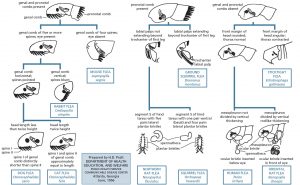Chapter 12 of the Truman’s Guide is devoted to “Fleas, Ticks and Other Ectoparasites.” Because our previous Spotlight (Learn more about ticks) focused on ticks, we are shifting to fleas this month. ’Tis the season, after all, and it’s a pest service segment that is making a comeback after many years of being pushed to the industry sidelines thanks to on-pet treatments.
The Guide covers eight common flea species, including:
- Cat flea (Ctenocephalides felis) —This is the most commonly encountered flea by pest management professionals (PMPs) in and around residential accounts. Despite its common name, it can also be found on dogs, coyotes, foxes, raccoons, skunks and possums.
- Dog flea (C. canis) — Dr. Gerry Wegner, BCE-Emeritus, notes that this species is encountered more often on dogs and cats in Europe. In the United States, it’s occasionally found on feral dogs and cats, as well as on nuisance wildlife.
- Human flea (Pulex irritans) — This species is found nationwide, but seems most common on the Pacific Coast. Humans are its preferred hosts, but in a pinch a pig or dog will do.
- Oriental rat flea (Xenopsylla
cheopis) — Behold the chief carrier of the causal organisms of bubonic plague and murine typhus. The flea is found in seaport towns, often on Norway and roof rats. It’s also common in the southern United States and in Southern California, and occasionally bites humans. - Northern rat flea (Nosopsyllus fasciatus) — Found on rats and mice nationwide, this flea is more commonly encountered in northern states. It is capable of transmitting plague among rodents, but does not usually bite humans.
- Sticktight flea (Echidnophaga gallinacea) — This species is found primarily on poultry in the southern and southwestern United States. Its common name stems from the female flea’s penchant for attaching firmly to its host, forming severe ulcers on the head or neck of domestic fowl; the ears of dogs, cats and rats; and on nearly any part of a human.
- European mouse flea (Leptopsylla segnis) — Primarily found on rats in the Gulf Coast states and in California, this species becomes problematic for humans when a heavy rodent infestation is present.
- Ground squirrel flea (Diamanus montanus) — This flea is found on rock squirrels and ground squirrels throughout western North America. It bites humans “readily,” the Guide states, and is responsible for many of the plague cases in the southwestern United States.
Flea Management
A focus on the basic tenets of integrated pest management (IPM) — inspection, identification, treatment and followup — is important in flea control, as is setting expectations for customers. They need to understand that full cooperation with your team is needed for success, including laundering or discarding pet bedding and working with their veternarian for an effective on-pet treatment program.
Explain the flea’s life cycle, emphasizing that control of the pupae present at the time of treatment can be more difficult than control of the other life stages. Therefore, some adult fleas will likely emerge for up to two weeks after the initial treatment.

Leave A Comment